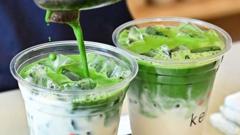The worldwide passion for matcha is reaching unprecedented levels, with a surge in popularity driven primarily by social media exposure and Japan’s tourism revival. The green tea, known for its vibrant color and health benefits, is being incorporated into everything from beverages at cafes to gourmet desserts. Influencers sharing tips and recipes under the "#MatchaTok" hashtag have amassed millions of views, contributing to this phenomenon.
As the demand for matcha grows, imports are struggling to keep pace. Lauren Purvis of Mizuba Tea Co. reported that her business is witnessing rapid depletion of supplies, once measured in months, now running out in mere days. Some cafes are reportedly requesting as much as a kilogram of matcha each day, illustrating the desperate need to fulfill customer cravings.
However, this skyrocketing demand is colliding with challenges including declining tea crop yields due to extreme heat conditions, tariffs imposed by the U.S. on Japanese goods, and an aging farming population in Japan itself. The Kyoto region, a crucial area for tencha leaves - the base for matcha - is suffering from poor harvests exacerbated by climate extremes, leading to empty store shelves as tourists flock to famous matcha locales.
Retailers are reacting to shortages by limiting the quantities of matcha sold per customer. For example, prominent tea establishments in Uji, a city in Kyoto renowned for matcha, are restricting purchases to ensure fair access amid rising visitor numbers.
Production hurdles have caused a 30% increase in tea prices at institutions like Chazen, a Tokyo chain specializing in traditional tea ceremonies. Despite the shortages, there is a silver lining – the surge in demand is prompting a greater interest in Japanese culture and, ultimately, a rise in the number of matcha growers. According to Japan's agricultural ministry, matcha production has tripled over the past decade, and green tea exports spiked by 25% last year.
In light of the shortages, advocates are pushing for a more mindful approach to matcha consumption, urging consumers to respect the tea’s heritage and opt for lower-grade options better suited for cooking. The Global Japanese Tea Association insists that this distinction should help sustain and promote the craft behind Japanese tea culture.
The rise in matcha prices due to the U.S. import tariffs – set to reach 15% – poses further challenges for distributors. Yet as demand remains high, industry insiders suggest that the current frenzy may stabilize in the next few years. Masahiro Nagata of Matcha Tokyo believes the trend towards exorbitantly priced low-quality matcha may not be sustainable, indicating a potential correction in the market.





















